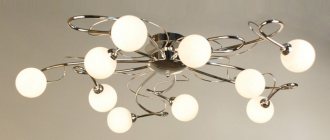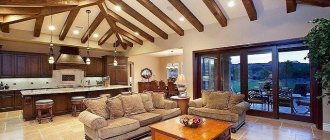Principle of operation
The operating principle of a traditional chandelier is simple: using a stationary switch, power is supplied to the device. The lights on the control panel are a little more complicated. In appearance, they are no different from ordinary ones.
A signal-receiving element is built into their design, which is skillfully camouflaged and therefore not noticeable. The remote control allows you to turn the light on/off and adjust its brightness from a long distance - from 30 to 100 m.
The lighting circuit on the remote control often includes halogen lamps and LEDs, which makes energy consumption economical.
Types of chandeliers
Buyers are offered a large number of models of lighting fixtures: pompous and discreet, massive and compact, monochrome and colorful.
Based on the type of construction, they are divided into suspended and ceiling-mounted. Hanging chandeliers are attached to a hook installed in the ceiling using a chain or string. The junction of the wires with the wiring and the elements with the hook is masked with a decorative plate.
The length of the cord differs for different models; usually, it can be adjusted at the request of the owners. They are made from different materials: metal and textiles, crystal and glass, wood and paper, etc. They are made in different styles and forms.
Multi-tiered hanging options look luxurious, asymmetry attracts attention, strict geometry makes the interior modern.
Suspended models can be single-shade or have a frame to which lamps are attached. An interesting option is with clusters of 5-6 lampshades suspended from the base on cords.
If the lengths of these strings are the same, then a classic light composition is obtained. Various-sized pendants create fancy multi-level art objects.
Pendant lamps differ in the orientation of the shades. The preferred option is when the lamps “look” up - this position provides light dispersion that is comfortable for the eyes.
If the ceiling surface has a mirror-like gloss, it is better to choose a device with downward-facing shades. An alternative idea is to purchase a chandelier with adjustable spotlights that can be easily turned to the sides.
Another type of design is a surface-mounted light fixture attached to the ceiling using a strip. This is an option for rooms with low ceilings.
More often such products are made in the form of a plate. They can be multi-segmented or a one-piece structure. The lamp shades of this type of lighting fixtures are usually made of glass or plastic. The more transparent the material, the more light the device transmits.
To enhance the lighting function, models are equipped with mirror reflectors. Under the lampshade there is one or more lighting sources. The disadvantage of ceiling lamps is that to replace a burnt out light bulb you have to remove the ceiling lamp.
According to their style, chandeliers are divided into:
- classic chandeliers are voluminous, elegant products with an abundance of pendants and other decorative elements. They create a festive atmosphere and are therefore suitable for decorating living rooms and halls.
A variation of this type is crystal chandeliers, the decor of which is made of crystal. The material enhances the light from lamps and creates mesmerizing shimmers.
This product gives a luxurious look even to a modestly furnished room. Classics have been at the peak of popularity for decades now; they never go out of fashion;
- Floral style is a subtype of the classics. This category includes models decorated with plant motifs: forging in the form of climbing stems, lampshades in the shape of flowers, floral patterns, etc.;
- chandeliers in the “modern” style - this includes lamps of non-standard shape: an originally designed sphere, a complex composition of decor and lampshades in the spirit of minimalism, strict geometry, etc.
A departure from tradition is harmonious in modern and eclectic interiors.
- Japanese-style chandeliers - the land of the rising sun - are in trend today. “Japanese” options are characterized by correct lines and restrained decor. In their production, plant materials (or their skillful imitation) are used - rice paper, bamboo, wood;
- Vintage chandeliers are antique-style lighting fixtures made of crystal, glass and metal.
Vintage style features:
- laconic lampshades;
- intricately curved fittings;
- complex patterns;
- colored glass;
- non-traditional shapes (dome-shaped cage lamps, or, conversely, strict polygons);
- light colors in the design;
- Eco chandeliers harmonize with the decor of country houses, and bring the warmth of natural materials to city apartments.
Models are usually made of wood and decorated with natural decorations: feathers, animal horns, pine cones, compositions of straw and leaves, etc.
These can be either natural elements or their plausible imitation. “Eco” items harmoniously complement simple “rural” styles – country, Provence.
Eclectic options look impressive - two-tier models, the “floors” of which are made in different styles. A striking example is a wide metal ring created in the high-tech spirit with built-in lamps above a classic chandelier, decorated with pendants and lampshades in the form of candles.
Based on the presence of additional functions, there are laconic models and options with a “bonus” in the form of a remote control with a power adjustment function.
Renaissance. Lamps in the style of the Renaissance
The materials for the manufacture of lamps are bronze, iron, copper, brass; ordinary or Murano glass is used for chandelier shades, sconces and floor lamps. The decor of Renaissance lighting sources is distinguished by harmonious and subtle ornamentation. In the ornaments of lamps in the Renaissance style, stylized leaves of acanthus, oak, and vine are widely used, in addition, wicker, ribbon are used, and the shell motif is widely used. Products made of transparent glass are painted with paints; products made of colored glass can imitate precious stones - jade, carnelian, malachite.
Baroque. Baroque style lamps
Baroque
(Italian barocco - “prone to excess”, late 16th - first half of the 18th centuries) - a style that originated in Italy as a contrast to the ideals of classicism and rationalism. Baroque embodied new ideas about the unity, boundlessness and diversity of the world, about its dramatic complexity and eternal variability.
The most characteristic features of Baroque are grandeur, pomp and dynamics, catchy floridity, a predilection for spectacular entertainment, strong contrasts of scale and rhythm, materials and textures.
At this time, elegant salons and boudoirs, furnished with special luxury, become the center of communication. Lamp lamps are also becoming a favorite type of fine art. The Rococo style is characterized by lighter designs of lamps, their elements become more elegant and sophisticated. Crystal is widely used in the form of pendants of various shapes (ball, rhombus, drop, leaf). Bright colors are replaced by delicate pastel tones - white, pink, fawn, light blue. The Rococo style is characterized by matte gold and silver.
Characteristics of chandeliers
The main characteristic is power. This parameter even affects the appearance of lighting fixtures. The indicator consists of the power of the lamps on the chandelier. The more shades a chandelier has, the more powerful it is.
The recommended option is 15-25 W per 1 m2 of room.
The choice of a lamp suitable for a chandelier is important:
- incandescent lamps - these sources emit a cozy light that is comfortable for the eyes. True, incandescent lamps spend half of the energy consumed on heat generation, so they are not economical.
The products burn out quickly, and their ability to get very hot makes them unsuitable for textile and paper lampshades;
- energy-saving lamps - characterized by economical energy consumption, long service life, and brightness. The buyer can choose a “cool” white option, which provides maximum illumination, or a homely, cozy yellow;
- halogen lamps are a type of energy-saving light sources, the distinctive features of which are durability and brightness;
- fluorescent lamps - sources that provide bright, cold, harsh light;
- LEDs are lightweight, almost non-heating sources of bright light.
Another characteristic of lamps is material. More often, lampshades and shades are made of plastic, durable glass, crystal, textiles, and paper.
The frame is usually made of metal, wood or plastic. Sometimes completely unexpected materials are used as decoration - feathers, dried berries, etc.
pros
In modern apartments you will no longer see a dim Ilyich light bulb hanging alone from the ceiling. Lighting devices ennoble the interior and create lighting suitable for the room of the appropriate purpose.
In the bedroom, a soft and cozy light is desirable, conducive to rest and relaxation; in the living room, when receiving guests, it is bright and festive; in the nursery, it is powerful, but at the same time comfortable for the eyes.
Not only the intensity of the light matters, but also its color. Using the color of lampshades and shades, it is easy to adjust the shade of lighting.
Advantages of different chandelier light options:
- yellow light is good for the eyes; This is a timeless classic, a universal option;
- white light (emission from fluorescent lamps in transparent shades) increases performance, but soon tires with its harshness;
- the red glow excites and increases blood pressure;
- orange lighting speeds up the pulse and stimulates the appetite (this is a great option for the kitchen);
- blue glow relaxes the nervous system and lowers blood pressure;
- green light gives comfort to the eyes and has a slight calming effect - this is a suitable option for a bedroom or nursery;
- the radiance of violet or blue color with prolonged exposure is depressing, irritating, and even causes depression; Such devices are not suitable for rooms where people spend a lot of time with the lights on.
A chandelier is also a means of creating the right atmosphere.
Ethnic styles. Lamps in ethnic style
Ethnic style
- this is a collection of colors, decorative items, furniture, materials characteristic of a particular country. Ethnic style in the interior involves creating an environment using national coloring, characteristic of the traditions of a particular people, a particular culture. We will highlight the stylistic images of some countries that evoke associations with a particular country. We won’t write about country lamps “in Russian” here; that’s the subject of another article.
The most extravagant of all existing styles, the most exotic and grotesque. Africa is natural minimalism: simple forms, rough textures. All interior products are made in a specific color scheme - shades characteristic of the desert are used (gold, gray, beige, sand, pink, terracotta, brick) in combination with black, brown and khaki. In the manufacture of African-style lamps you can often find unusual materials - sand, fur, feathers and claws, coconut, animal skins and so on.
India is a land of fairy tales and legends. This is a combination of luxury, gold, sophistication and subtle taste with asceticism, modesty, simplicity of lines and shapes. In interior items, including lamps, Indian style is reflected in a cocktail of ornaments, colors, patterns and textures, magnificently sharp and inlaid furniture. A distinctive feature of the Indian style is the use of carved decorative arches. Indian style uses turquoise, green, crimson, orange, and other colors that are completely unique in their kind.
Indian style lamps
They use a combination of floral patterns in combination with geometric ones. Speaking about products designed in the Indian style, one cannot fail to mention lampshades and lampshades draped in rich Indian fabrics, as well as lamps made of colored glass and lamps draped with fabric in the shape of a bell with frills, and decorative lamps in the form of lanterns.
Materials used for “ Indian” lamps
: wood - teak, ivory, mother-of-pearl, silver, brass, forged metal, feathers. Techniques: enamel, forging, embossing, carving, inlay.
features and ending with cultural heritage. The style of the Moroccan style is also multifaceted and very harmonious, despite the mixing of many cultures (styles).
Lampshades produced by artisans from Morocco have nothing in common with European lamps. Their bodies are made of brass or a copper alloy and covered with dark brown varnish, and the frame is covered with buffalo or camel skin, previously soaked in a mimosa solution. Each lamp is a work of art. It has an original author's drawing and symbolism. The pattern consists of an interweaving of stylized plant motifs, calligraphic inscriptions and geometric shapes. For example, the octahedron (octahedron) implies infinity and happiness, which is why North African floor lamps and table lamps even have lampshade frames often octagonal in shape. In floral designs, Moroccan craftsmen depict henna and peach, symbolizing life and rebirth.
Thus, oriental style lamps
- an extensive group that includes original lamps made from natural materials that are somewhat similar and have absorbed the national flavor of their country.
We show both Moroccan and Indian lamps on the site in one search result for oriental lamps
.
Author: Online store of lamps and electrics Novosvet74.
When using this material, a link to the author is required!
Before choosing a lamp for the interior you are creating, you should familiarize yourself with the characteristics of the model. This will allow you to determine which style it belongs to.
Historically established styles are not always reflected in their pure form in the design of lampshades and chandeliers. In some cases, the style can be determined very roughly - there are simply no clear boundaries. Therefore, each designer relies only on his own experience and intuition.
Minuses
Among the disadvantages of lamps are:
- installation difficulties (some of the problems are related to installing the lamp on a suspended ceiling);
- labor-intensive maintenance : to wash a ceiling lamp, you will have to remove it, and for a hanging chandelier you need to unscrew the shades every time you clean it.
Caring for any material is associated with difficulties: glass, due to its fragility, requires care and caution, paper and textiles are difficult to clean from dirt, wood can become “overgrown” with fungus, etc.
In addition, when washing lighting fixtures, precautions must be taken;
- price: models from reliable manufacturers are not cheap;
- fragility: when buying an inexpensive chandelier from an unverified manufacturer, you should not count on its long service life. They usually use low-quality materials that quickly fail and cannot be replaced or repaired;
- breakdowns: even products from reliable manufacturers are not insured against breakdowns. This is especially true for complex models on the control panel. From time to time the chandelier needs repairs.
How to choose a chandelier
Choosing a lamp involves taking into account the following points:
- room dimensions;
- shape of the room;
- color scheme and interior style;
- purpose of the premises;
- the presence of additional lighting sources (floor lamps, table lamps, fireplace);
- energy consumption and maximum power supported by wiring;
- features of cartridges.
Hanging options have been created for “high” rooms. A suitable distance from the bottom point of the lighting fixture to the floor is 2.5 m.
The rule does not apply to unusually high ceilings - here the length of the suspension is chosen based on aesthetic considerations. In rooms with low ceilings, surface models look harmonious.
The size and shape of the room's chandeliers matter. Spacious rooms require bright central lighting. This could be a multi-tiered chandelier or an option with several shades. It is possible that a single light source will not be enough.
L-shaped rooms or elongated rooms need several lighting fixtures. Two identical symmetrically located chandeliers or different, but united in style, lamps look harmonious.
Lamps allow you to zone a room - to highlight a place for relaxation and an area for eating in the living room. An alternative option for delineating a room is to combine a chandelier with another lighting fixture.
So, above the dining table you should hang a bright crystal “object of art” in a classic style, and at the same time “bestow” the area for comfortable relaxation with the soft light of a wall lamp or floor lamp.
For characteristic long narrow corridors, the following option is suitable: round ceiling or spotlights located in a line at a distance from each other.
The color scheme of the interior plays a role. Light walls and furniture reflect light, while dark colors absorb it. To prevent a room in the noble colors of “burgundy”, “rich blue” and “chocolate” from looking like a cave, it is better to choose bright multi-shade models.
It is better to choose a chandelier with a reserve in terms of power. If the light is too bright, the intensity of the glow can be easily reduced using the power control function that modern lamps are equipped with.
The general rule is: the larger the area, the brighter the light should be. Multi-shade models look good in spacious rooms.
Having chosen the model you like, pay attention to the bases. Non-standard sockets create difficulties when purchasing light bulbs.
The choice also depends on the purpose of the room that the chandelier will illuminate. Low lighting causes drowsiness, while bright lighting tones and excites. The appearance of the lighting fixture also creates a corresponding mood.
- Festive pompous classic chandeliers with pendants , forged elements, rhinestones, and patterns are appropriate for the living room. If the ceiling height allows, multi-tiered design is encouraged.
In small rooms with low ceilings, such a product looks bulky and inappropriate. Here, near-surface options are preferred, which can also be elegant and luxurious thanks to their original design and skillful decoration.
- When choosing a children's lamp, it is important to pay attention to safety. Here we need models made of textiles and plastic.
It is better to avoid fragile glass and crystal - a child can easily get hit by a ball (cube, car, book) in the lighting fixture and be injured by the fragments. You should not place the chandelier above the crib.
The design of a children's chandelier should be either neutral or bright and attractive for the young owner of the room. Popular models are those whose lampshades are decorated with princesses, cars, teddy bears, and images of popular “cartoons.”
- The kitchen is characterized by high humidity. Particles of soot and fat fly in the air here during the cooking process on the stove or other household appliances. This determines the requirements for a chandelier for the kitchen - practicality and ease of care. Textile lampshades and designs with an abundance of intricate shaped elements, in the bends of which dirt accumulates, are not appropriate here.
- The bedroom is a place of rest and sleep. The lighting here requires soft, non-irritating lighting. It is desirable that the design of the lamp matches the style of the room, a harmonious combination with the furniture, cornice and curtains, and bedspread. Calm undertones are preferred. You can install several light sources: next to the bed, on the ceiling, in the corners of the bedroom.
It’s good if the product is equipped with a function for adjusting lighting modes. A remote control wouldn’t hurt either – it’s so nice to put down a book and immediately lie down on the pillow instead of getting up and flicking the switch.
Lampshades made of frosted or colored glass are a solution specifically for the bedroom. These details provide soft light that is appropriate for a relaxation room.
- The bathroom is a room with high humidity. A bathroom chandelier should be made of moisture-resistant material. Placing it closer to a water source than 1.5-2 meters is dangerous.
Typically, bathrooms are not very spacious - it is not necessary to choose powerful lamps here. An additional lighting source should be installed above the mirror - for this, lamps built into its frame are often used.
The color of the lighting fixture is of great importance. Products in neutral colors are popular - white, beige, steel. Interesting options with lampshades decorated with patterns.
You should be more careful with colored products: to one degree or another, the lighting of the room will take on the shade of the lampshade, and this will certainly affect the state of the nervous system of the people in the room.
Sometimes a designer's play with color turns familiar, even hackneyed models into original products that set the tone for the environment. Thus, a lamp in a classic style with multi-colored decorative transparent elements looks bright, festive, and unusual.
The glare on the walls and ceiling fascinates with its bright tints and transitions of tones. “A motley masterpiece” will ideally complement an eclectic style and/or become a tool for combining shades of furnishings, a means for creating a holistic “picture”.
Postmodernism. Lamps in postmodern style
Classic style
in the design of lamps it is dictated, first of all, by ostentation. Multi-horn design, noble metal body, elegant glass pendants are features of a classic style.
Modern.
Currently, smooth curved lines, plant motifs, materials with rich decorative possibilities - natural stone, metal, colored glass - fill design objects with secret meaning. Any modern lamp is an individual work of authorship, and not an item of mass production.
Which is better
Features of an “ideal” lamp:
- reliability - high-quality components, high-quality materials. These are the products that reputable manufacturers offer;
- light weight - the lighter the chandelier, as far as possible given its dimensions, the better;
- efficiency - preferable options involve the installation of energy-saving light sources.
The model must correspond to the style and functional features of the room it will illuminate. The direct purpose of the lighting device is to provide the correct light.
Therefore, the best chandelier in each case is the one that has sufficient power and gives the desired shade of radiance.
For example, a relaxing bluish glow is appropriate in the bedroom, but a lamp of this shade in the kitchen will give an unappetizing blue color to the food. For this place, the best option is an orange lampshade.
Exploitation
Operating the chandeliers is simple and safe. Traditional models are controlled using switch buttons.
The options on the remote control are controlled from a long distance (you can also use a switch if desired). The remote control requires periodic battery replacement.
During use, the product becomes dirty. It needs to be cleaned at least once every three months. To thoroughly wash the surface lamp, it will have to be removed.
For hanging models, simply unscrew the shades and wipe the frame itself with a damp cloth, paying attention to decorative curves and recesses.
Antique style lamps
Under antique style
imply the style of architecture of Ancient Greece and Ancient Rome. The reasons for this are the simplicity and clarity of the composition, the forms and designs of which were harmonious and proportionate to man.
Styling the interior in an antique style can be limited to using only floor and wall lamps, excluding chandeliers and pendants. However, if the room has general overhead light, the ideal option would be a lamp in the form of a stone bowl hanging on chains, with small “vessels” located around its circumference.
Antique style lamps
made using various patinated metals and stone. The main decorative technique can be an ornament (for example, in this ceiling chandelier).
Precautionary measures
The following precautions will help you avoid dangerous consequences during operation of the chandelier:
- Before choosing a lighting device, it is important to find out: what power the wiring in the room is designed for; the total power of the product should not exceed this value;
- models with lampshades made of textiles, paper and other flammable materials require “cold” light bulbs: energy-saving, LED, fluorescent. Hot incandescent lamps create a risk of lampshades catching fire;
If the ceiling of the room is made of heat-resistant material, the lamps also need to be non-heating, otherwise dark circles above the lampshades cannot be avoided;
- When buying a lamp, it is important to pay attention to the strength of the fasteners, especially if the lighting device is heavy;
- Cheap incandescent lamps can burn out the sockets of most modern budget chandeliers: when choosing a light bulb for a lighting fixture, you should read the recommendations in the product data sheet.
Following the rules of wet cleaning will help avoid electrical injuries and damage to the product:
- Before you start wet cleaning, turn off the device;
- during the washing process, carefully ensure that moisture does not get on the bases and contacts;
- after “hygienic procedures”, do not turn on the lamp for at least another 20 minutes;
- Before assembling the lighting fixture, make sure: are the parts of the structure dry?
Malfunctions and repairs
Common lamp failures include:
- mechanical damage (“children are to blame” or breakdowns during washing of the device);
- broken contacts or soldering coming off at the base;
- melting of thin wiring;
- combustion (as a result of a short circuit) or broken contacts in the remote control of the device.
There are two main reasons why chandeliers fail:
- non-compliance with the operating rules specified in the product passport: for example, the use of unacceptably high power light bulbs or cheap incandescent lamps in lighting fixtures, which heat up and melt the insulation and sockets;
- low quality product made from unreliable “disposable” materials.
If the chandelier does not turn on, the first step is to understand where the breakdown occurred: in the device itself or before it (a break in the network, a faulty switch, a burnt-out wire transmitting electricity).
If it's all about the lamp, you should turn to a specialist for help. Today, specialists come to your home: this is very convenient, because transporting a chandelier to a workshop is problematic.
A professional will quickly determine the cause of the breakdown and make repairs: solder broken contacts, replace a burnt-out cartridge, and eliminate faults in the remote control module.
True, many modern models cannot be repaired - this is due to manufacturers saving on materials.
What material are chandeliers currently sold from?
More recently, crystal, glass, metal and plastic chandeliers could be seen in stores and markets. Currently, the production of lighting fixtures has expanded significantly, so a lot of paper, textile, wood and leather chandeliers have appeared on sale. Alloys of various metals can be used to make a metal chandelier. The most important thing to remember is that if you have a high-tech interior, then you should not buy a chandelier made of wood, and a classic interior - paper lamps.











